Colors in Excel
When you know how Excel’s color system works, you can do some great work. We’ll take a brief look backwards at the rudimentary color palette of Classic Excel, then explore the enhanced capabilities of the color system introduced in Office 2007.
The Color Palette (Excel 2003 and Earlier)
You may remember the default color palette of Excel 97 through 2003, shown below. The palette a mishmash of blindingly bright tiles amidst a multitude of dark gloomy colors. I think it was designed by someone who only came out of his dungeon at night.
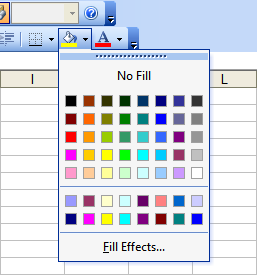
There were 56 colors in the palette, and you could independently modify any of them. But you could not use any colors beside these 56 in your workbook, except in AutoShapes. Each workbook could have its own palette (but only one palette), and you could assign one workbook’s palette to another workbook. The sixteen tiles in the bottom two rows were not always available for general editing, but were reserved for chart lines (bottom row) and chart fills (second row from the bottom).
What I miss about Excel 2003 is not so much the available colors in the palette, but the fact that you could tear them away from the toolbars and drag them to where you were working. They stayed open until you closed them, which saved hundreds of clicks a day (or hour), and their proximity to your work saved miles and miles of mouse travel.

In fact, Classic Excel contained a variety of formatting tearaway toolbars, and I miss all of them. Here is a screenshot of many of them, in case you’re nostalgic. (Sniff.)
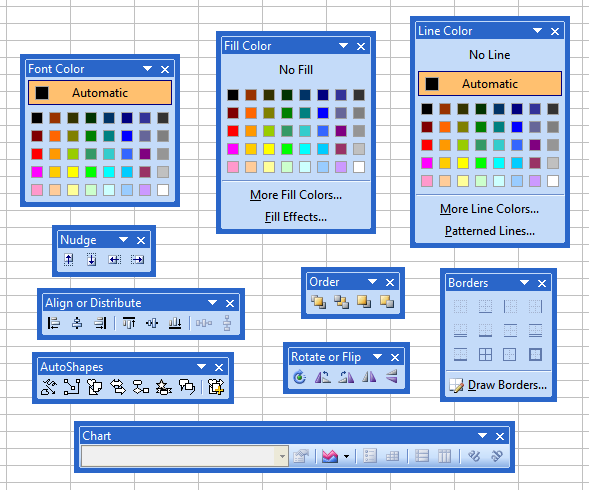
The best thing that Microsoft could do for Excel 2016 would be to reintroduce this kind of old-school functionality, and restore our lost productivity.
The default palette was pretty grim, and the defaults made for some butt-ugly charts. But it was easy enough to tailor your own palette, as I had done with guidance from the color picker at ColorBrewer2.org, thanks to Cynthia A. Brewer, Pennsylvania State University. Below are shown the default palette (left) and one of my custom palettes (right). My bottom three rows were medium, light, and very light shades of 8 colors; I lightened up the grays in the last column, I replaced the dark colors in the top row, and made one of the dull greens in the middle into one with more life.

When a workbook’s color palette is changed, all colors in the workbook are subject to change.
As attached as we were to Excel 2003’s color system, we welcomed the new color system that came with Excel 2007.
The Color Chooser (Excel 2007-2013)
The Classic palette has been replaced with a similar color chooser, which shows all of the colors in the chosen theme. The colors are more organized, where each column of the grid of colors has shades of the same base color. This shows the default Office 2007-2010 theme. The colors are somewhat dull, but they are a major improvement over the Excel 2003 colors, and reportedly these colors are distinguishable by those with the most common color vision deficiencies.

As you mouse over the color chooser, names of the colors pop up. Names like “Black, Text 1, Lighter 35%” and “Aqua, Accent 5, Darker 25%”.
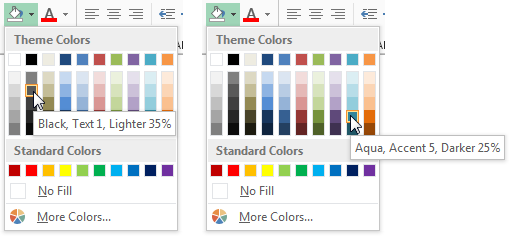
This table shows the names for all color tiles in the default Office 2007-2010 theme. The name consists of the color name in the first row, “Aqua”, then the label from above the table, “Accent 5”, and finally the adjustment of the color, “Darker 25%”.

For Text 2 and the Accent colors, the sequence of shades goes Lighter 80%, Lighter 60%, Lighter 40%, Lighter 0%/Darker 0% (the baseline shade), Darker 25%, and Darker 50%. There’s a large jump between the baseline color and the next color at Lighter 40%. I wish they’d decided to use Lightness values of 25%, 50%, and 75% instead of the chosen 40%, 60%, and 80%. I also wish there was a way via the user interface to adjust this percentage, but you need VBA if you want to keep a color associated with the theme.
Theme Colors
We’ve been looking at the default Office 2007-2010 color theme, but there are many more to choose from, which you can access from the Page Layout tab. Office 2013 has a new theme, which is a little livelier than the old 2007-2010 theme, further improving on the Classic Excel colors. There are a slew of other themes too, but it seems most of them are skewed to much towards a particular color to be good for general use.
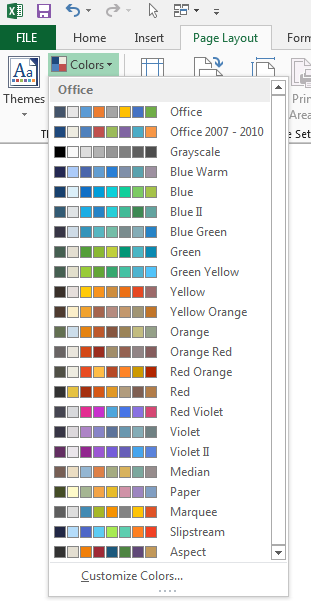
Below are the color choosers for the Office 2007-2010 default theme (left) and the Office 2013 default theme (right). The 2010 theme’s colors are somewhat drab, although a major improvement over the default Excel 2003 palette, and reportedly friendly to those with color vision deficiencies. The Office 2013 colors are brighter, and look very good in charts. I’ve actually grown to like working in Excel 2013, much more than in 2010 and especially in 2007; I suspect the happier colors have contributed to my acceptance of 2013.

Here are the names of the colors in the Office 2013 theme. The color names have changed, but the percentages are all the same. Also, the standard colors are unchanged.

At the bottom of the list of color themes is a button labeled Customize Colors, which leads to this dialog. It is populated below with the Office 2013 colors. There is a preview of how the colors look together, and each color dropdown opens a color picker that lets you access all 16+ million combination of red, green, and blue pixels. then you can name and save your custom theme.

Here I’ve populated the accent colors with pure, fully saturated versions of the Office 2007-2010 theme.
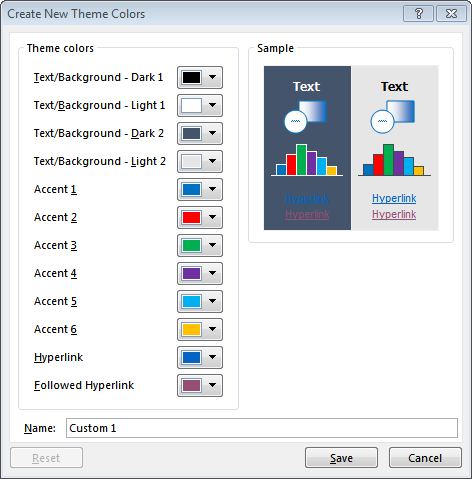
Whoa, that’s pretty bright…
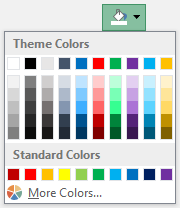
Here are the color names for my custom palette. Notice that Excel tries to guess the names of the colors, or it probably has a lookup table. Turquoise, for example, is somewhat deeper than Aqua.

Notice also the percentages. These are locked in. You can’t change them in the theme color dialog above, you can only change the main colors in the first row.
As with Classic Excel, each workbook has its own theme, which may be shared with other workbooks through the custom theme mechanism. But you could use other colors, including the standard colors from the bottom row, and using the color dialog (More Colors) you could access all the millions of colors available to Windows.
When a workbook’s color theme is changed, all colors that were selected from the theme are subject to change, but any colors defined using More Colors will remain unchanged.
More Colors (Custom or “Recent” Colors)
At the bottom of the color picker is a button labeled More Colors.
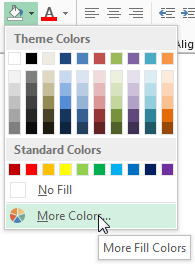
This opens the familiar old Colors dialog used in Classic Excel and a gazillion other applications. The Standard tab shows a hexagonal pattern of colors, with the color of the selected object highlighted in the hex and along the bottom if the color lies on the white-to-gray-to-black axis.
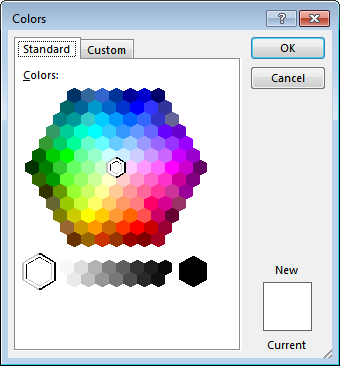
If you select a different color, the New/Current graphic in the bottom corner lets you compare the newly selected color with the original color.
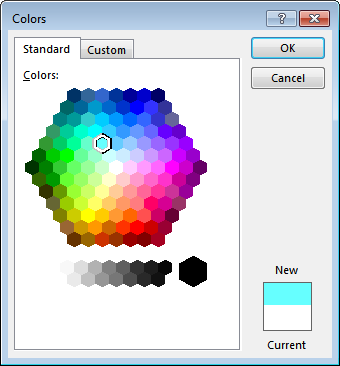
If the hex doesn’t provide just the proper shade, click on the Custom tab. You can change the color by dragging the white crosshairs in the hue-saturation rectangle to the left, or by dragging the black triangle up and down the luminance slider. Or if you know the RGB values you can simply type them into the boxes. The New/Current graphic updates as you adjust the color.

You can also select the HSL color model and enter hue, saturation, and luminance values directly.

When you’ve selected a new color, it appears in a new category of Recent Colors. You can select as many different colors as you need, but only the ten most recently used colors stay in the color chooser.
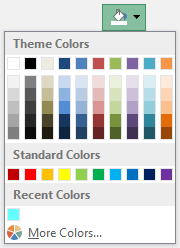
Chart Colors
Remember those Excel 2003 charts? Here’s a simple stacked column chart.
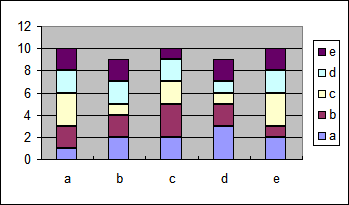
Professor Tufte’s nightmare.
It’s a little better when I use my custom Excel 2003 palette, but there are still too many dark lines everywhere.

If you clean up the dark lines, the Excel 2003 chart doesn’t look too bad.
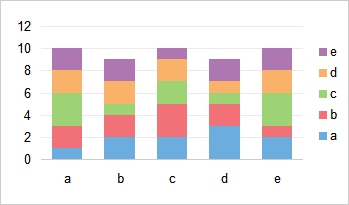
Here’s the chart using the default Office 2007-2010 color theme. Legible but pretty drab except for the aqua bars on top. Much better than the default 2003 chart, though.
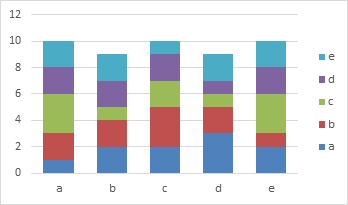
Here is the same chart after changing to the Office 2013 theme. I can’t say that it’s any more legible, but less drab is good.
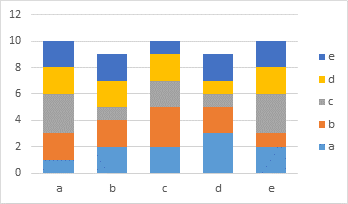
Here I’ve applied my bright and bold custom theme.

Ouch! It’s a good reminder to use a reputable source for your color scheme. As mentioned earlier, one good source is the color picker at ColorBrewer2.org, thanks to Cynthia A. Brewer, Pennsylvania State University.
Formatting Chart Colors
Once you have your chart, there are many ways to format its elements. I’ll illustrate with formatting the fill color of one of the series in the column chart.
One of the most useful shortcuts in Excel is Ctrl+1 (that’s the numeral one). I use it so much I find myself trying to use it in other programs, and it never does anything.
What Ctrl+1 does in Excel is open the formatting dialog or task pane for the selected object. Of course, you could right click on the object and choose the Format [Object Name] button from near the bottom of the pop-up menu, but Ctrl+1 is cooler.
So select the series in the chart and click Ctrl+1 and in Excel 2013 the Format Data Series task pane opens. Its default position is docked to the right edge of the workbook window. I’ve clicked the Fill Color dropdown, and the familiar color chooser pops up.
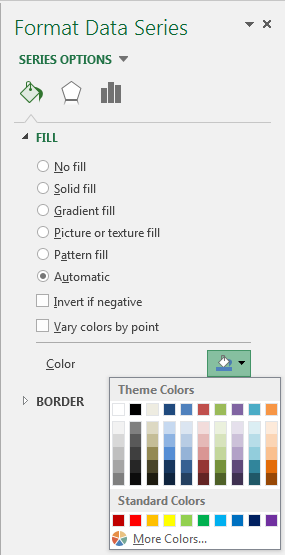
The taskbar can be undocked by clicking on its top edge and dragging it to where you want to use it. In this way it somewhat resembles the long lost floating tearaway toolbars from Classic Excel. Somewhat.
I’ve floated the task pane over the chart and clicked the Fill Color dropdown to reveal the color chooser.
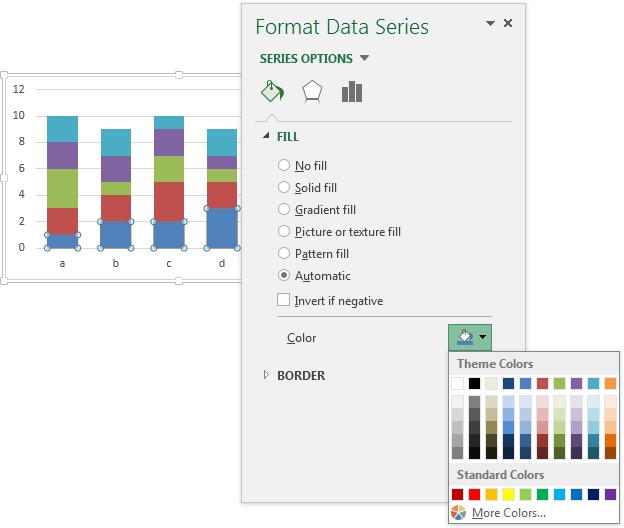
The formatting task pane was introduced in Excel 2013. In Excel 2007 and 2010 there is a formatting dialog, which floats modelessly over the worksheet. When you select the Solid Fill option, the Fill Color dialog appears, and clicking it shows the color chooser.

In Excel 2013 and 2010, but not in 2007, when you right click on a chart element, in addition to the standard pop-up menu, there is a small floating formatting mini-toolbar which has context-relevant formatting buttons (Fill and Outline are displayed below) and a chart element dropdown that identifies the selected element and allows you to select any other element in the chart.
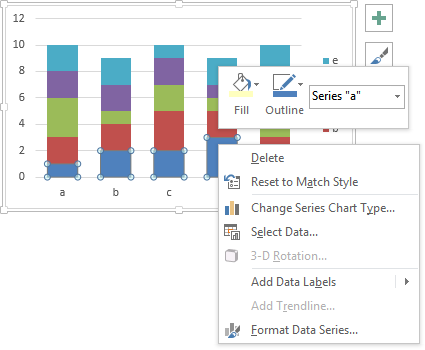
Click on the Fill button, and the color chooser appears.
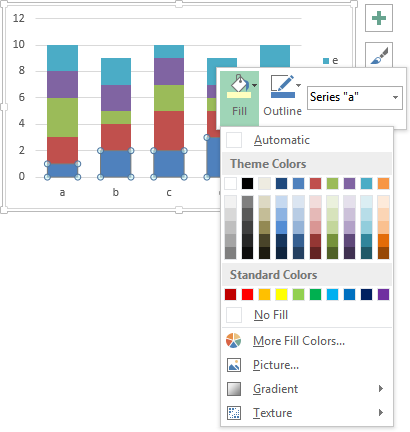
Now for the cool part. When you mouse over a color tile in the chooser, the selected element temporarily takes on the color of that tile, giving you a preview of how the element will look with that color applied. The formatting task pane in Excel 2013 and the formatting dialog in Excel 2007 and 2010 do not give you this preview.
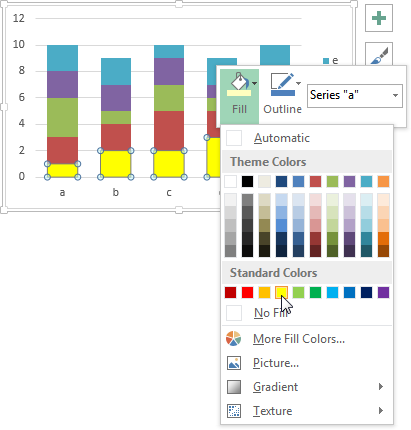
You can also use the controls on the Chart Tools > Format tab to format the chart elements. Select the series and click the Shape Fill button to reveal the color chooser.
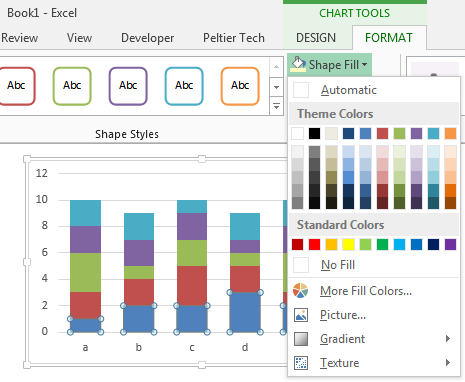
Mouse over a color tile, and as before the selected series is previewed with that fill color. Nice.
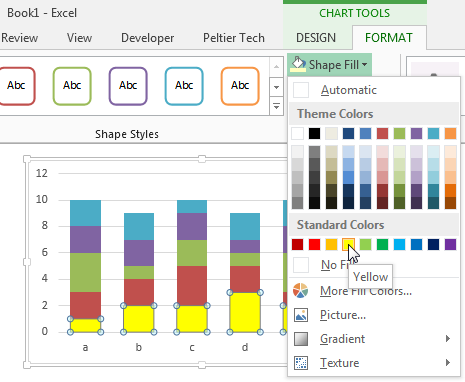
You can even format some elements of the chart using controls on the Home tab. Even though it’s in the Font group of controls, the Fill dialog works on the selected series. Click on the paint can and the color chooser pops up.
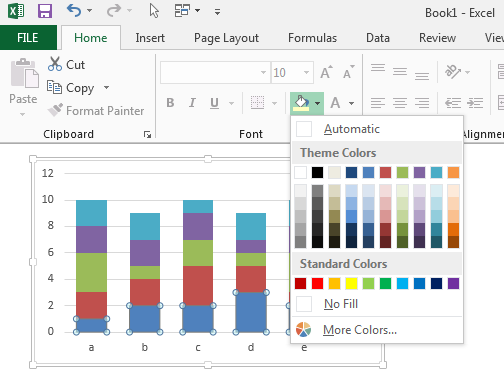
Mouse over a color tile, and the series is filled with that color.
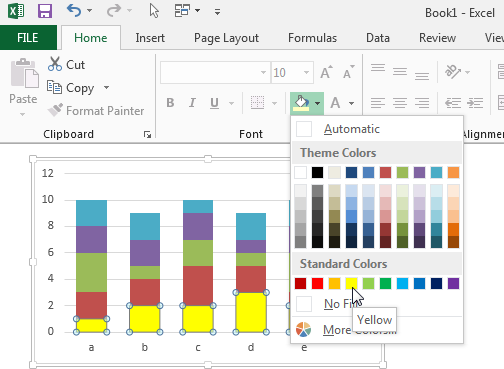
That preview feature is pretty cool, a good reason to use anything but the format task pane or dialog for most formatting actions. These protocols work the same for line or border colors, font properties, etc., and the previews are featured when controls on the right-click mini-toolbar or ribbon are used.
Using Copied Custom Colors
Let’s return to our original stacked column chart. We’re going to change the series colors so they range from red-orange at the bottom to blue at the top.
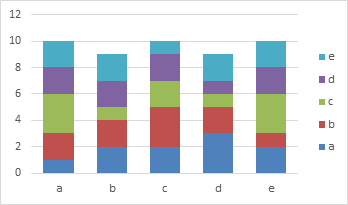
How do you get the colors into the chart? Well, you can define other colors by entering RGB values, but if you have more than a few, you’ll get pretty bored. I have a method that’s much more fun.
I have several worksheets on which I have stored various color sequences, based on the work at ColorBrewer2.org, thanks to Cynthia A. Brewer, Pennsylvania State University. If that name sounds familiar, it’s because I keep mentioning it, and you should visit the site and find some decent color schemes.
Here is a small view of one of my color worksheets. The columns are color schemes (red-blue, orange-purple, etc.), the rows are groups of three colors, five colors, seven colors, etc. each cell is shaded with the particular color, and the RGB values are shown in the cell for reference.
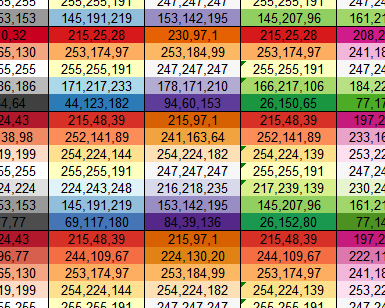
I usually start by copying the block of cells with the colors I want, and paste them somewhere in the workbook.

The color chooser in a new workbook shows the default color theme and standard colors, and no recently used colors. Here’s an easy way to get the colors from the copied range into the Recent Colors section of the chooser. Remember there’s a limit of ten recent colors.
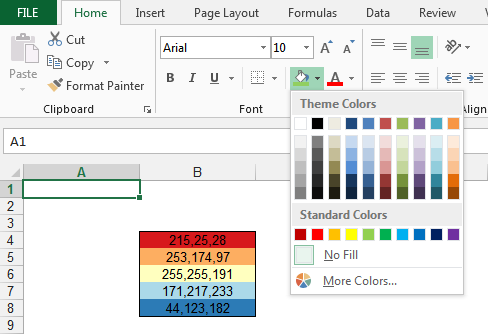
Select one of the colored cells. Click on the Fill dropdown, and then click More Colors at the bottom of the color chooser.
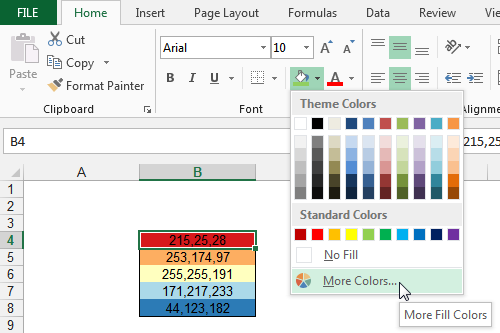
The Colors dialog pops up. When a color-theme-formatted object is selected, the current color in the Colors dialog is black and the standard tab is active. However, when an object formatted with a custom color is selected, its RGB values are plotted on the Custom tab, and the Current/New graphic shows this color.

Don’t make any changes in this dialog, just click OK to close it. Now when we check the color chooser, the color that we saw in the Colors dialog appears in the Recent Colors list.

That was easy, we didn’t have to type any numbers or anything.
Now we can select the series we want to format and click the Fill dropdown to reveal the color chooser. Yes, the newly added custom color is still there.
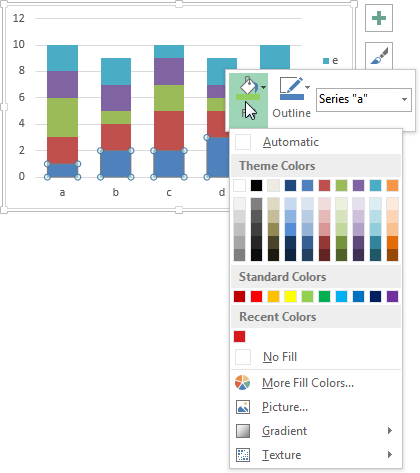
Mouse over the new color, and behold the series previewed with that color.

Release the mouse and the chart series has been filled with the new custom color.

Select the next colored cell, click the Fill dropdown, and click More Colors.
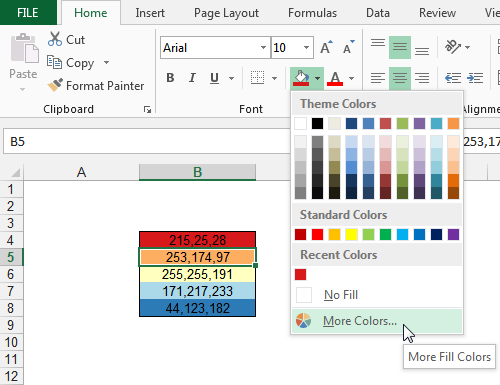
The new cell’s fill color is plotted in the Colors dialog.

Click OK to insert this color into Recent Colors.
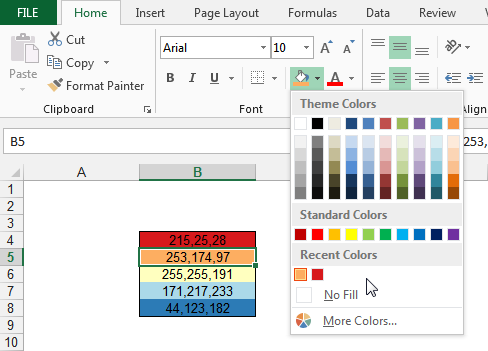
Return to the chart, right click the next series click the Fill button, mouse over the new color in the chooser, and the color is previewed in the series.
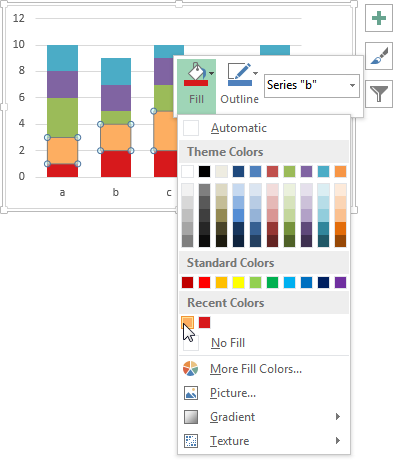
Here’s the chart, 2/5 of the way done.
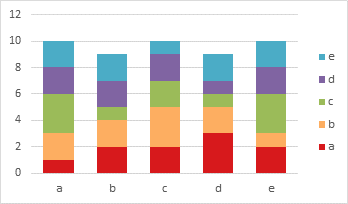
Lather, rinse, repeat until all of the colors have been added to Recent Colors.
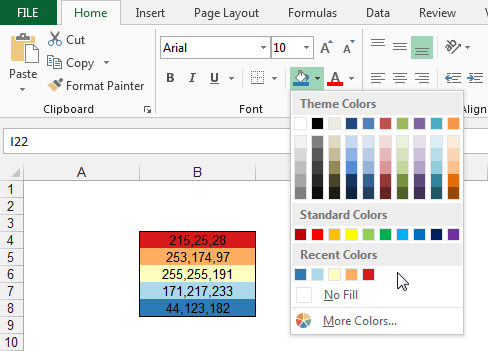
Here is the chart with our desired color scheme applied.

The workbook will remember these colors when it is closed and reopened. The recent color tiles will rearrange themselves, with the most recently used color furthest to the left. This makes the most recent color easy to find when you’re applying the color to many objects.
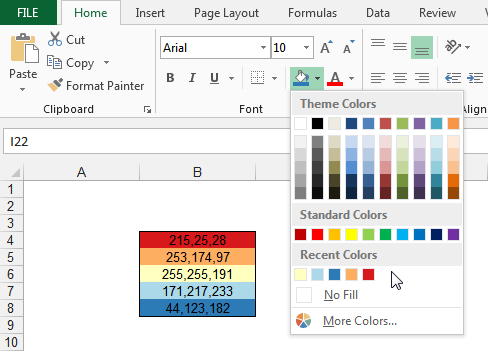
Further Investigation
Office 2007 Colors
This article has covered most of the user interface part of Excel’s colors. With some VBA and the patience to flush out details of the object model, you can further expand Excel’s capabilities. Of course, the object model that came out with Office 2007 was somewhat half-baked, and there were problems with some combinations of color and percentage brightness or darkness not being obtainable. Some new VBA elements were introduced in 2010 that fixed a few problems and seemed to have added some of their own.
For further coverage of Office 2007’s color mechanisms, check out Tony Jollans’ article, Colours in Word 2007. Tony has spend lots of time figuring out and documenting Office 2007’s colors in excruciating detail.
Echo Swinford shows how to hack the XML code of the theme to add your own Custom Colors to the color chooser in PowerPoint 2007 Custom Colors. These are different from Recent Colors and appear in a Custom Colors section above the Standard Colors section.
Mr. Spreadsheet himself, John Walkenbach, covered Office 2007 colors in Excel 2007 VBA Challenge, More On Office 2007 Colors, and Exploring Theme Colors, in which he describes some of the glitches he’s encountered.
Choosing Colors
I’ve mentioned several times that good colors can be found at ColorBrewer2.org, thanks to Cynthia A. Brewer, Pennsylvania State University. There are innumerable color scheme designers on the web, but I prefer ColorBrewer’s complete schemes.
Perceptual Edge hosts an article by Maureen Stone, Choosing Colors for Data Visualization, as well as Stephen few’s articles Practical Rules for Using Color in Charts and Uses and Misuses of Color.
Juice Analytics has some advice about color use in Color Has Meaning and other pages linked from that one.
NASA has an extensive library of pages about Using Color in Information Display Graphics.
UXmatters has a series of articles about Color Theory for Digital Displays: A Quick Reference: Part I, Part II, and Part III.
To check your colored images for color vision deficient viewers, visit Vischeck.



Jorge Camoes says
Jon, great and very thorough post. Let me just add something. When Stephen Few and Andreas Lipphardt created the Chart Tamer add-in for Excel they asked Maureen Stone to design a color palette. The add-in can still be found online and you can add its palette as a theme. It’s still my default color scheme.
Elazier Barbosa says
Beautiful work, congratulations!
Elazier
Larry Caretto says
Jon — let me echo Jorge’s praise and add something. Sometimes I have to match a color on an office document that someone else has created. 1. Select the item with the color you want to match. 2. Enter the command to format that item. 3. When the color chooser appears, click the More Colors button. 4. When the colors dialog appears click the Custom tab. 5.Write down the RGB values for this color. 6. Exit all the dialogs with no changes. 7. Select the item you want to format. 8. Repeat steps 2, 3, and 4 above to display the RGB values. 9. Enter the RGB values you copied in step 5. 10. Exit all the dialogs. Please let me know if there is a simpler way to get an exact match.
Jon Peltier says
Jorge –
That was a nice palette. The problem with it was that it was implemented without warning to the user (or option not to implement it), and it overwrote custom palettes developed by companies for their own branding.
Seb says
Jon,
I tried Echo Swinford’s XML hack to add custom colors but that does not seem to work in Excel. It does work in PowerPoint however.
Seb
Jon Peltier says
Seb –
Thanks for the feedback. I have not tried Echo’s XML approach to an Excel theme.
I found the xml file for the theme I created for this exercise. It’s here
C:\Users\Jon\AppData\Roaming\Microsoft\Templates\Document Themes\Theme Colors\Jon Bright.xml
It’s a very readable file, easy to see the structure and figure out what to change if you’re inclined:
Seb says
The clrScheme part of the XML can be addressed easily enough through the user interface. I was rather referring to the “Custom colors” section that you can have between the “Theme colors” & “Standard colors” sections. To have that, you need to add a new section to the XML (custClrLst).
After, my original comment, I noticed the colors were added on the palettes from the “Drawing Tools Format” ribbon (shape fill, text fill, etc.) but not on the palettes from the “Home” tab.
I didn’t have that issue in PowerPoint.
Echo Swinford says
Hey, gang,
You can add custom colors to a PPT template, an Excel template, a Word template or an Office theme. In all of these files, you’re still adding the same code to the theme#.XML file. Also, although I wrote that tutorial when Office 2007 first came out, the technique is the same for Office 2010 and Office 2013 files as well.
Thing is, the custom colors don’t show up on ALL of the color choosers in Excel and Word the way they do in PPT. They will be available on many of the choosers, but not all. (Jon, please have a talk with the Excel devs about that, won’t you? ;-) )
Seb says
Thanks for the clarification Echo. That’s what I noticed too. I thought it might be a bug on my computer or a result of some corporate restrictions.
I run Office 2007. It’s unfortunate that’s not been corrected since.
Sébastien
Abe says
Sometimes when I save an Excel file, the recently used color will be available when the file is next opened and sometimes it won’t. Is there a way to save a file so that the recently used colors are always kept?
Jon Peltier says
Abe –
Once Excel is closed and reopened, the color controls are reset. However, I seem to recall that a workbook’s own recently used colors are persistent.
Ivan says
What is the purpose of having the top row of colors separate from the rest of the colors?
Jon Peltier says
Ivan –
I think that is simply to show that those colors, in between the light and dark, are the standard shades.
Paul Ellmore says
It would be nice to have the capability of deleting a color from the “recent colors” since various colors could have been tried before a final selection. Those un-wanted colors remain in “recent colors” and should have the capability of removal. Using Excel 2007 on Windows 7.
Jon Peltier says
What I’ve done once or twice is color a dummy cell with a custom color to bring it back to the front of the list.
colordude says
Interesting post, but IMO should never have been necessary due to the overly complex color handling (and lack of documentation from MS)
Jeff Weir says
I’m a bit late to the party, but wanted to say thanks for another great article. It worries me a bit that all the careful choosing of colors I’ve done when setting CF conditions will be completely undone if someone uses a different theme than I had when I chose the colors in the first place.
I’m building a Conditional Formatting add-in to replace the underwhelming one, and I think I’ll add an option there to convert all theme-based colors to actual colors. Might be something worth adding to your chart tools too, Jon…assuming you haven’t already done it.
Jon Peltier says
Hey Jeff –
If you use More Colors rather than choosing from the built-in palette, don’t those custom colors survive a theme switch?
Jeff Weir says
Yes they do. But users are much more likely to use the built-in pallette, with no idea that their carefully chosen color choices might go out the window on someone else’s pc. I’m proposing a “fix colors” button to clear the themecolor info and instead populate the .color property to ensure “what I see is what you get”.
Brett Gregory says
Jon: If you use More Colors rather than choosing from the built-in palette, don’t those custom colors survive a theme switch?
Jeff: Yes they do.
This may partially answer a question to a problem I’m facing. If I email out a sheet with my own custom theme used then it will just take on whatever theme the user has – RIGHT?
I have set up some macros in the Ribbon to put in some of the colours I can’t easily get in Ex 2016 (such as the very nice R235 G255 B20). These are put in to cell fill as RGB, so they should stay there in an emailed sheet – RIGHT?.
However, that won’t solve all the problems I’ll have with emailed colours, JW’s ColorPicker might.
My biggest question is: Can I put JW’s userform, and modules into my CustomRibbon Add-in (active for all workbooks) and call them up with a Ribbon button? I think “Yes” but before I go to a lot of work it would be really helpful to know if I’m on the right track please. I would intend to change JW’s picker so that it has 60 colours (which would obviate the somewhat dopey repetition of grey 128 128 128 that Themes gives us), and I would need to create two of them – one for fills and one for fonts.
Jon Peltier says
Brett –
If you apply a theme to a workbook, it stays with the workbook until someone chooses a different theme for that workbook. But the theme of one workbook has no effect on another workbook. You would have to change the theme of the default workbook template to make that stick.
…very nice R235 G255 B20
Kind of lemony for my taste. I prefer R255 G235 B20, but more often I use R255 G255 B153 for a more subtle highlighting of cells I want to draw to someone’s attention.
Brett Gregory says
Ah, I see. Thanks for that Jon. In that case I’ll email a sample to someone, and see what they get.
Yes, they’re nice colours too. R200 G255 B0 is another that I use, generally just for checking off stuff that I’m doing myself.
Garrett Fuller says
This post is incredible.
Sometimes Office will do something I can work around, but drives me insane because I don’t know why it is behaving like that.
I think you just solved all of my excel color questions. Even ones I didn’t realize I had.
Thanks!
Paul PW says
Hello Jon. TY for this comprehensive article.
One odd aspect that I cannot find explained anywhere is when changing the color of text in a cell comment [Select text in a comment; right-click; select Format Comment; ‘Font’ dialog box is shown]. This is in Excel 2010. For some reason the color chooser dialog still uses the ‘Classic’ Excel 2003 pallet and not the newer 2007+ pallet of shaded accent colors. The classic pallet dialog also excludes the “Recent Colors” list and the “More Colors…” selector.
I need a particular text color in a cell comment. Do you know if there’s any way in Excel 2010 to access the “classic” pallet and modify it?
Jon Peltier says
Paul –
What you describe is still true of Excel 365. Crazy.
It’s a pain, but you can manually adjust the colors in the relic palette. Go to File > Options > Save. Where is says “Preserve Visual Appearance of the Workbook”, click the Colors button, and a dialog pops up that lets you change these colors. One. By. One.
Ugh. So I put together a small VBA add-in to do this automatically, and I’ll write a post about it sometime. Basically, it takes most of the active workbook’s Excel 2007+ theme color popup and maps the colors to the Excel 2003 56-color palette.
Click this link to download a zip file containing the add-in: LegacyPaletteFromThemeColors.zip. Download, unblock, and install (or just open) the add-in, following instructions here: Install an Excel Add-In.
Arnis says
Great post, enjoyed the overview. Chuckled when I got to this part: “If that name sounds familiar, it’s because I keep mentioning it, and you should visit the site and find some decent color schemes.”
Thanks!
David Price says
I cannot believe that Microsoft have not bothered to fix this issue with the custom colors. I use custom colors extensively in Word and PowerPoint and I happily said to the client “yes, I can do it in Excel as well” and then it only half works!
If only Microsoft could be bothered to go back and fix their mistakes, rather than keep adding new features nobody asked for.
Jon Peltier says
Hi David –
I’m not sure what is the issue that you refer to.
David Price says
I refer to the custom colours i have defined in xml not appearing in the the Font colour or Fill colour drop-downs but they do appear in Shape Fill.
Jon Peltier says
Yeah, I saw that in a few comments 9 years ago. And still, in the latest builds of Excel 365, the problem exists.
I think the whole color scheme/theme thing is low priority. Microsoft will probably trash the current system and deploy something else, rather than fix what we’ve been trying to use.